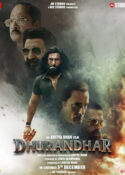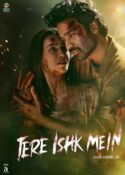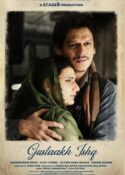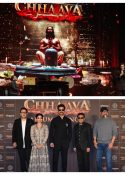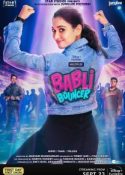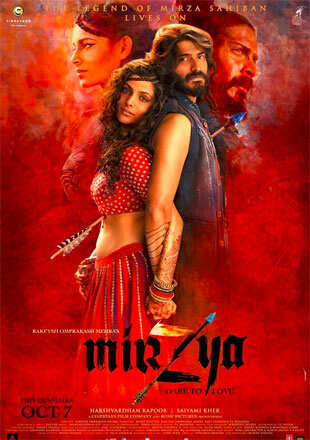 Subhash K Jha revisits Rakeysh Omprakash Mehra’s unstoppably unique romnce, Mirzya, which is celebrating 9 years since it hit the big screen. We also hear from the director about the making of the film including the casting process, working with in credible lyricist Gulzar and so much more.
Subhash K Jha revisits Rakeysh Omprakash Mehra’s unstoppably unique romnce, Mirzya, which is celebrating 9 years since it hit the big screen. We also hear from the director about the making of the film including the casting process, working with in credible lyricist Gulzar and so much more.
As I watched the maverick movie making magician Mehra’s fifth directorial pilgrimage into the mysteries of cinema— Mirzya doesn’t mention its debut making lead pair as ‘Introducing’.That’s because continuity and renewal are critical to Mehra’s vision of cinema. He moves, no he glides, from one era to another without punctuation marks in pursuit of that uncorrupted core of humanism which makes life worth living even in the worst of times (and honestly, it can’t get any worse than now, can it?).
Mirzya is a very simple yet extremely layered love legend. The lovers here face what lovers everywhere have faced since love was discovered in the human heart. As in Rang De Basanti, Mehra creates two level of storytelling, one that is situated in the present times with the lovers going through the love tropes with a kind of gentle persuasiveness that makes destiny seem charmingly welcome, and the other love story that unfolds in a snow swept landscape of the past with a fatal fury.
The provocative uniqueness of Mehra’s Mirzya flows out of its narrative format. Stylish and yet improvisational Mirzya imbues the love legend with a casual grace and a disarming ardour. A large portion of the film’s inescapable charm is traceable to the lead pair who are no gym-produced mannequins. Flesh and blood, they bleed and bawl,plead and brawl, with their tempestuous love for one another being the epicenter of their conflict.
And Gulzar—God bless his insight into the human heart—gives them such lovely lines to speak. Harshvardhan and Saiyami own those lines with proprietary pride. The exemplary sound design (Pranav Shukla) is so textured and tonally correct we can hear every crack in the lovers’ hearts.
This brings me to the film’s exceptional technical qualities. Mirzya is arguably the most technically accomplished piece of cinema in a very long time. Spaces in the heart are virtually manifested on screen in the characters’ clothes, demeanour, performance and posture. The visual landscape deifies the emotional content of the plot without hammering in the link between what we see and what the characters feel. The romance in the past fuelled by a nomadic mating dances (Raju Sunderam’s choreography is divinely erotic) and rituals from folk art which coalesce in a comfortable union of a fugitive heritage and contemporary conventions.
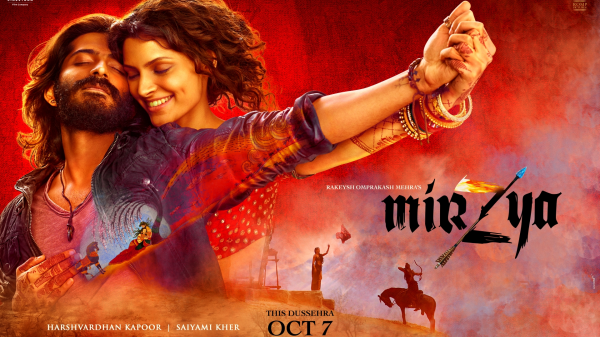
All of this is achieved with a subtlety and tenderness which are not all accessible or obtainable in the first viewing. Mirzya tells a deceptively simple tale of star-crossed love with a flummoxing flourish. Why the two love stories fused in concurrent movements which allow no room for demarcation lines? This question gets its answer in the empowering befitting finale where, shall we say, guns and arrows meet without a violent conflict of interest between the two weaponry.
For me, what made Mirzya unstoppably unique was its even temper. Even during the moments of heightened emotional conflict and outburst Mehra is in full and supreme command of his character’s words and action. The music by Shankar Ehsaan Loy is the life and breath of the lovers’ journey from a childhood togetherness to doomed adulthood. Every musical piece in the narrative tells a story.
Curiously, Gulzar seems to borrow some of the film’s external and interior worlds from Emily Bronte’s Wuthering Heights. The stable-boy Adil that Harshvardhan plays could be Heathcliff from any era (considering Mehra’s penchant for era-less drama). The debutant plays the tormented lover-boy using his eyes that speak a million words of recrimination. Harshvardhan’s forte is pain and hurt. He expresses these with an honesty reminiscent of Dilip Kumar in Dil Diya Dard Liya.
Saiyami Kher as Suchitra is no comestic beauty. She is real and unstoppably vivacious, a Kajol of the new generation. Both the debutants hold the camera in close-ups with an unflinching directness unique to the new generation of actors. Anuj Choudhary as Suchitra’s royal fiancé is adept at expressing an arrogant hurt. But the scene stealer is Anjoli Patil as Zeenat the ironsmith’s sensuous daughter who has the eternal hots for Adil. Anjoli chews the meat off every scene that she has including a very crucial wedding–chamber scene where she breaks your heart.
It is the older actors who let us down. Or is it the script that doesn’t allow them room to show their worth? Rakeysh Mehra’s favourite K K Raina’s face is so lost in whiskers we barely recognize him. Art Malik as Suchitra’s over-possessive father over-punctuates his performance and hams it up in one major drunken scene where he actually rolls on the floor like a tantrum-throwing child..And Om Puri as the lohar and the narrator barely gets two scenes.
There are some terribly bright child actors in the film lending a sense of artless innocence to the luminous goings-on. Every frame of Mirzya speaks a language that echoes Luis Bunuel. A lot of the credit for the captivating cadences of the storytelling must go to Shankar Mahadevan’s astonishing music and Pawell Dyluss’s soul-searching cinematography which makes every shot a do-or-die endeavour without sacrificing the spontaneity and fluidity in the narration.
Then there is P S Bharati’s editing. She fuses the two eras where the two love stories unfold with an effortlessness that makes the director’s existential philosophy—that life moves from one conflict to another without the luxury of full stops—seem like the only way love can be expressed.
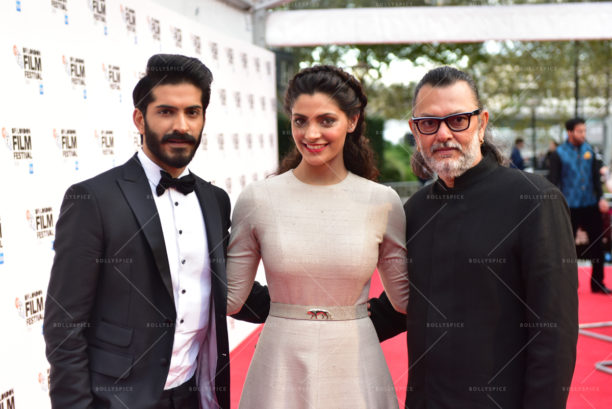
Of course, we know love is a many-splendoured emotion. But Mirzya makes us feel with time-stopping stillness when the only sound we hear is that of two hearts beating, that this is only was to feel love, with a ferociousness that precludes options. No wonder we FALL in love. How else would a movie maker like Mehra be able to catch the journey down during the fall?
Speaking about Mirzya, Rakeysh Mehra says, “Time just flies. Now when I look back at Mirzya it was quite an avant garde attempt. My first foray into a musical where more than an hour of the film was silent. The music of Mirzya deserves a special mention both Gulzar bhai and Shankar-Ehsaan-Loy gave their best. For me it was a stepping stone a huge learning curve for the musicals I will make in the future.”
How did the idea of Mirzya come to Mehra? “I had seen a stage version of the legend of Mirza Sahibaan when I was in college. Like all legendary love sagas this one too ended as tragedy. But the one question that haunted me was, why at the end of the tale did Sahibaan break all the arrows of Mirza? If she hadn’t broken them perhaps he wouldn’t have died. The question stayed with me over the years. When I was making Bhaag Milkha Bhaag I was also working on Mirzya. Once Gulzar Bhai and I decided to do Mirzya we were sure it would be newcomers in the two roles. For the male lead Harshvardhan was more or less decided. I knew him from the time he would hang around my sets with his sister Sonam on the sets of my Delhi 6. I knew he was right for the role. For the role of Sahibaan we zeroed in on two faces Saiyami Kher and another girl. Both the girls were told either could be the final choice. There was absolutely no rivalry between them as they prepped for one part. Then there’s Anuj Choudhary playing the third protagonist. We got the cast that the story needed.”
Adding, “We took Harshvardhan and Saiyami out of Mumbai to Delhi to prepare for their parts. We felt the only way they could blossom into the Mirzya and Sahibaan was if they were taken out of their environment. Incidentally this is the only love legend from India where the love birds have a physical relationship. Harsh and Saiyami surrendered completely to their roles to the point that they would be on the sets constantly even when they were not required. The portions where the childhood phase in Mirzya and Sahibaan’s life was played out had Saiyami commenting enviously on the quality of the child actors’ performances. ‘You should continue shooting with them only. You don’t need us,’ Saiyami said. We were constantly improvising on the sets. I’d warn Harshvardhan and Saiyami the minute they would get out of character; they would immediately stop and start again. Gulzar Bhai and I are practically neighbours in Bandra (Mumbai). If I step out of my home, he lives just a stone’s throw away. And Shankar-Ehsaan-Loy have done all the music recordings in a studio close to where Gulzar Bhai and I stay. We recorded 300 hours of music for this film. We were constantly interacting, exchanging ideas, mulling. Even the film’s Polish cinematographer Pawel Dyllus joined us in Mumbai months before the shooting just to get familiar with the team. Mirzya was 2 hours and 8 mins long. My wife P S Bharathi who edits all my films turned it into a completely different entity from what I had shot. We had shot 800 hours of film. To cut down to 2 hours was not an easy task.”

